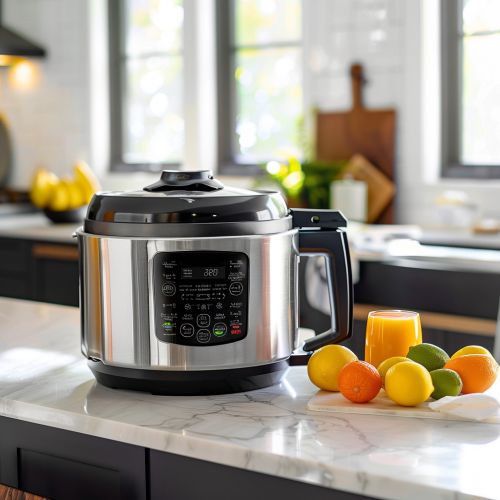Pressure cooking: Difference between revisions
(Created page with "== Introduction == Pressure cooking is a method of cooking in which food is prepared using water or another cooking liquid in a sealed vessel known as a pressure cooker. This technique employs high-pressure steam to cook food quickly and efficiently. The pressure cooker operates by trapping steam, which raises the internal pressure and temperature, significantly reducing cooking times compared to conventional methods. == History == The concept of p...") |
No edit summary |
||
| Line 27: | Line 27: | ||
Electric pressure cookers are modern appliances that combine the functions of a pressure cooker, slow cooker, rice cooker, and more. These devices feature built-in heating elements and programmable settings, making them user-friendly and versatile. Popular brands like Instant Pot have gained widespread popularity due to their convenience and multifunctionality. | Electric pressure cookers are modern appliances that combine the functions of a pressure cooker, slow cooker, rice cooker, and more. These devices feature built-in heating elements and programmable settings, making them user-friendly and versatile. Popular brands like Instant Pot have gained widespread popularity due to their convenience and multifunctionality. | ||
[[Image:Detail-79831.jpg|thumb|center|Modern electric pressure cooker on a kitchen counter.]] | |||
== Safety Features == | == Safety Features == | ||
Revision as of 12:48, 20 May 2024
Introduction
Pressure cooking is a method of cooking in which food is prepared using water or another cooking liquid in a sealed vessel known as a pressure cooker. This technique employs high-pressure steam to cook food quickly and efficiently. The pressure cooker operates by trapping steam, which raises the internal pressure and temperature, significantly reducing cooking times compared to conventional methods.
History
The concept of pressure cooking dates back to the 17th century when French physicist Denis Papin invented the "steam digester," a precursor to the modern pressure cooker. Papin's invention aimed to reduce cooking times and improve the extraction of nutrients from food. Over the centuries, the design and safety features of pressure cookers have evolved, leading to the development of modern electric and stovetop models widely used today.
Principles of Pressure Cooking
Thermodynamics
Pressure cooking relies on the principles of thermodynamics to achieve rapid cooking. When water is heated in a sealed environment, it generates steam, increasing the pressure inside the cooker. The increased pressure raises the boiling point of water, allowing food to cook at temperatures higher than the standard 100°C (212°F). This elevated temperature accelerates the cooking process and enhances the breakdown of complex molecules in food.
Pressure and Temperature Relationship
The relationship between pressure and temperature is governed by the ideal gas law, which states that the pressure of a gas is directly proportional to its temperature when the volume is constant. In a pressure cooker, as the pressure increases, the temperature also rises, enabling faster cooking. For instance, at 15 psi (pounds per square inch) above atmospheric pressure, the boiling point of water increases to approximately 121°C (250°F).
Types of Pressure Cookers
Stovetop Pressure Cookers
Stovetop pressure cookers are traditional models that require an external heat source, such as a gas or electric stove. These cookers typically feature a heavy-duty pot with a locking lid and a pressure regulator to control the internal pressure. Stovetop models offer precise control over cooking pressure and are favored by many professional chefs.
Electric Pressure Cookers
Electric pressure cookers are modern appliances that combine the functions of a pressure cooker, slow cooker, rice cooker, and more. These devices feature built-in heating elements and programmable settings, making them user-friendly and versatile. Popular brands like Instant Pot have gained widespread popularity due to their convenience and multifunctionality.

Safety Features
Pressure cookers are equipped with several safety features to prevent accidents and ensure safe operation. These include:
- **Pressure Release Valves:** These valves release excess pressure to prevent the cooker from exploding.
- **Locking Mechanisms:** Modern pressure cookers have locking lids that prevent the cooker from being opened while under pressure.
- **Gaskets and Seals:** Rubber gaskets and seals ensure an airtight environment, preventing steam from escaping.
- **Pressure Indicators:** These indicators show the pressure level inside the cooker, allowing users to monitor and adjust as needed.
Advantages of Pressure Cooking
Pressure cooking offers numerous benefits, including:
- **Time Efficiency:** Cooking times are significantly reduced, making it ideal for busy individuals.
- **Nutrient Retention:** The rapid cooking process helps preserve vitamins and minerals that might be lost during prolonged cooking.
- **Energy Efficiency:** Pressure cookers use less energy compared to conventional cooking methods due to shorter cooking times.
- **Flavor Enhancement:** The sealed environment traps flavors and aromas, resulting in more flavorful dishes.
Common Uses and Applications
Pressure cooking is versatile and can be used for a wide range of culinary applications, including:
- **Cooking Tough Cuts of Meat:** The high pressure and temperature break down tough muscle fibers, making meats tender and succulent.
- **Preparing Legumes and Grains:** Beans, lentils, and grains cook quickly and evenly in a pressure cooker.
- **Making Soups and Stews:** Pressure cookers are ideal for preparing hearty soups and stews in a fraction of the time.
- **Sterilizing Jars:** Pressure cookers can be used to sterilize canning jars, ensuring food safety during preservation.
Maintenance and Care
Proper maintenance and care are essential for the longevity and safe operation of a pressure cooker. Key maintenance tips include:
- **Regular Cleaning:** Clean the pressure cooker thoroughly after each use, paying special attention to the gasket and pressure release valves.
- **Inspecting Seals and Gaskets:** Regularly check the condition of seals and gaskets, replacing them if they show signs of wear or damage.
- **Storing Properly:** Store the pressure cooker with the lid off to prevent odors and moisture buildup.
